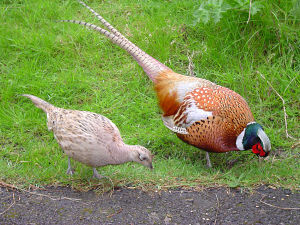Common Pheasant
Conservation status Least concern |

female (left) & male (right)
|
|
Scientific classification |
| Kingdom: |
Animalia
|
| Phylum: |
Chordata
|
| Class: |
Aves
|
| Order: |
Galliformes
|
| Family: |
Phasianidae
|
| Genus: |
Phasianus
|
| Species: |
P. colchicus
|
|
|
Binomial name |
Phasianus colchicus
Linnaeus, 1758 |
The Common Pheasant (Phasianus colchicus)
is a
gamebird in the
pheasant family Phasianidae of the order Galliformes,
gallinaceous birds.
The adult pheasant is 50-90 cm in length with a long
tail, often accounting for half the total length. The male (cock
or rooster) has barred bright brown
plumage and green, purple and white markings, often
including a white ring around the neck, and the head is
green with distinctive red patches. This bird is also called
the Common or English Pheasant, or just Pheasant. The males
are
polygamous, mating with more than one female; they are
often accompanied by a harem of several females.
The nominate race P. c. colchicus lacks a white
neck ring. This is however shown by the race Ring-necked
Pheasant, P. c. torquatus which after several
failed attempts was successfully introduced to the United
States in 1881.
The female (hen) is much less showy, with a duller
mottled brown plumage all over, similar to that of the
partridge. The birds are found on wooded land and scrub.
They feed on the ground on grain, leaves and
invertebrates, but roost in trees at night. They nest on
the ground, producing a clutch of around ten
eggs over a two-three week period in April to June. The
incubation period is about 23-26 days. The chicks stay near
the hen for several weeks after hatching but grow quickly,
resembling adults by only 15 weeks of age.
While pheasants are able short-distance fliers, they
prefer to run: but if startled they can suddenly burst
upwards at great speed, with a distinctive "whirring" wing
sound. Their flight speed is only 27 to 38 mph when cruising
but when chased they can fly up to 60 mph.
They are native to Asia but have been widely introduced
elsewhere, where they are bred to be hunted and are shot in
great numbers. The doggerel "up flies a guinea, bang goes
sixpence and down comes half-a-crown" reflects that they are
often shot for sport rather than as food. If eaten the meat
is somewhat tough and dry, so the carcasses were often hung
for a time to improve the meat by slight decomposition, as
with most other game. Modern cookery generally uses moist
roasting or farm-raised female birds.
Pheasant farming is a common practice, and is sometimes
done intensively. Birds are supplied both to hunting
preserves/estates and restaurants, with smaller numbers
being available for home cooks. Pheasant farms have some 10
million birds in the U.S. and 35 million in the United
Kingdom. The Common Pheasant is also one of the prime target
of small game poachers. The Roald Dahl novel "Danny the
Champion of the World" dealt with a poacher (and his son)
who lived in the United Kingdom and illegally hunted common pheasants.
The bird was brought to
Britain around the 10th century but became extinct in the
early 17th century; it was reintroduced in the 1830s and is
now widespread. Repeated reintroduction has made the
pheasant a very variable species in regard to size and
plumage. Pheasants have probably been present in North
America from the 18th century but became common in the wild
in the late 1800s. They are most common in the Great Plains, where they are often seen in hay, grass
wheat, and CRP fields. A preferred nesting site for them is
along fence rows, wheat, and under old machinery.
The term pheasant can also be used for other gallinaceous
birds such as the
quail or
partridge, and in North America it is occasionally used
to refer to the ruffed
grouse.
The
Green Pheasant of Japan is very similar to Common Pheasant,
but the males have greenish plumage. The Ring-Necked
Pheasant is the state bird of South Dakota, the only US
state bird that is not a species native to the United
States.
|
|
|
|
|
|
|
|
|
English Cocker Spaniel with Cock
|
References
- BirdLife International (2004).
Phasianus colchicus. 2006
IUCN Red List of Threatened Species. IUCN 2006. Retrieved on 09 May 2006. Database entry
includes justification for why this species is of least
concern




